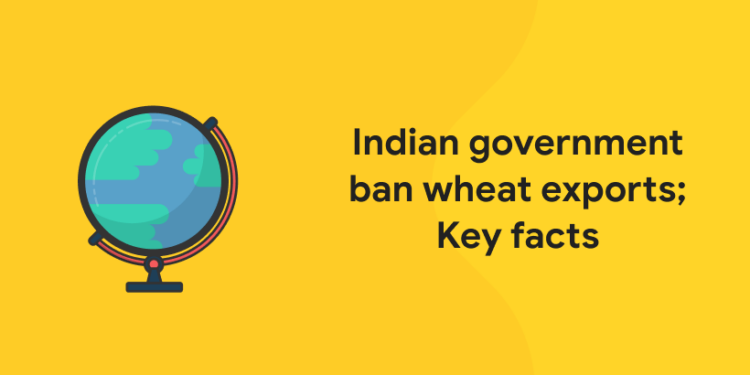Table of Contents
India banned wheat exports on Saturday, just few days after saying it was aiming record shipments this year, as a burning heatwave reduced output and local prices hit an all-time high amid strong export demand. The government said it would still let exports for letters of credit that have already been issued and on the request from countries that are trying “to meet their food security needs.”
“We don’t want wheat trade to happen in an unregulated manner or hoarding to happen,” commerce secretary BVR Subrahmanyam told reporters in New Delhi.
Although not one of the world’s top wheat exporters, India’s ban could drive global prices to new peaks given already tight supply, hitting poor consumers in Asia and Africa particularly hard.
This week India sketched its record export target for the fiscal year that started on April 1, saying it would send trade assignments to countries such as Morocco, Tunisia, Indonesia and the Philippines to find methods to increase shipments.
In February, the government predicted production of 111.32 million tonnes, the sixth straight record crop, but it could not reach the predicted production and reached only 105 million tonnes in May.
“The government’s procurement has fallen more than 50%. Spot markets are getting far lower supplies than last year. All these things are indicating lower crop,” the dealer said.
Cashing in on a rally in global wheat prices after Russia invaded Ukraine, India exported a record 7 million tonnes of wheat in the fiscal year to March, up more than 250% from the previous year.
“The rise in wheat price was rather moderate, and Indian prices are still substantially lower than global prices,” said Rajesh Paharia Jain, a New Delhi-based trader.
Grab Latest Study Materials! Register Here!
“Wheat prices in some parts of the country had jumped to the current level even last year, so the move to ban export is nothing but a knee-jerk reaction.”
In spite of a drop in production and government purchases by the state-run Food Corporation of India (FCI), India could have exported at least 10 million tonnes of wheat this fiscal year, Jain said.
The FCI has so far traded a little over 19 million tonnes of wheat from local farmers, against last year’s total purchases of a record 43.34 million tonnes. It bought grain from domestic farmers to carry out a food welfare programme for the poor.
Contrary to previous years, farmers wanted to sell wheat to private traders, who offered good prices than the government’s fixed rate.
“The Indian ban will lift global wheat prices. Right now there is no big supplier in the market,” another dealer said.
($1 = 77.4700 Indian rupees)
Grab Latest Study Materials! Register Here!
Global wheat prices since Russia invaded Ukraine
- India has banned wheat exports, the government quoted in a notification late on Friday.
- The world’s second largest wheat producer is aiming to calm local prices.
- Global buyers were banking on the world’s second largest wheat producer for supplies after exports from the Black Sea region dived following Russia’s invasion of Ukraine in late February.
Increasing food and energy prices pushed India’s annual retail expansion up towards an eight-year high in April, nourishing economists’ view that the central bank would have to uplift interest rates more strongly to control prices.
Wheat prices in India have increased to a record high, in some spot markets to as high as 25,000 rupees ($322.71) per metric ton, versus the government’s fixed minimum support price of 20,150 rupees.
Grab Latest Study Materials! Register Here!
Earlier this week, India defined its record export target for the 2022/23 fiscal year that commenced on April 1, adding it would send business delegations to countries such as Morocco, Tunisia, Indonesia and the Philippines to investigate methods to further raise consignments.
But a sudden and sharp increase in temperatures in mid-March makes the crop size smaller than predicted at around 100 million tonnes or even lesser, a New Delhi-based dealer with a global trading firm said, versus a government estimate for an all-time high of 111.32 million tonnes.
“The government’s procurement has fallen more than 50%. Spot markets are getting far lower supplies than last year. All these things are indicating lower crop,” the dealer said.
In April, India exported a record 1.4 million tonnes of wheat and deals were already signed to export around 1.5 million tonnes in May.“Indian ban will lift global wheat prices. Right now there is no big supplier in the market,” the second dealer said.
Grab Latest Study Materials! Register Here!
Unfair to blame wheat inflation on export curbs: India to WTO
1: Who was the first woman President of India?
At an informal meeting on agriculture, New Delhi told it stopped wheat exports for the benefit of local food security, and asked the WTO members to examine the exports information of the last four-five months to know the major wheat exporters and contractors details.
On Friday, New Delhi disputed that traditionally it is not a large wheat exporter and trades out only 0.5 million tonnes yearly eventhough as an exception, it exported 7.
EXPORTS AT RISK
“Based on the production estimates issued by the government in February, we could have comfortably traded much more than 12 million tonnes, but it now looks like we’ll be exporting around 10 million tonnes,” he said.
Even with the warm weather, India’s wheat exports could effortlessly cross previous year’s trades, said the government official.
But some traders more hopeless, with some projecting as much as a 10% drop in output.
“Diminishing supplies in spot markets are showing a bigger drop in the production. I think production could be down 10% to around 100 million tonnes,” said the India head of global trading firm, who declined to be named.
The government could stop exports if production drop come closer to such level, he said.
Addressing the Indian evacuations in Berlin, Indian Prime Minister Narendra Modi said at present many countries are fighting with a extreme shortage of wheat.
“Big nations are worried about food security, and at this time India’s farmers are coming forward to feed the world,” Modi said.
Before the nearly 50% growth in global wheat prices, those paid by the state-run Food Corporation of India (FCI) exceeded world prices, making exports less attractive.
Now, private merchants are busily buying wheat from Indian farmers for exports.
So far this year, FCI’s wheat purchases are 38% lower than the previous year, according to official data, showing both higher purchases by private merchants for exports and some drop in crop output as well.
Local prices have increased by 15% in some markets, said a Mumbai-based dealer with a foreign trading firm, in another potential sign of more buying for exports and less supply.
I hope this article was helpful. The key point to clear an exam lies in methodical and planned preparation. If you are a candidate who wants to pursue your dream career and looking for a good start, our Entri app has got it covered for you. Our team will help you with content and insights related to the topics of your concern. Subscribe to our app today and enrol yourself into various programmes our app offers. Tune in to the app to stay updated regarding various aspects of the subject you are interested in. Feel free to post any queries and doubts in the comment section. We will try our best to reach out. Push away all those self-doubts and negative thoughts. Try to have a clear vision. Ask yourself why you want this. Focus on the good and work hard.













